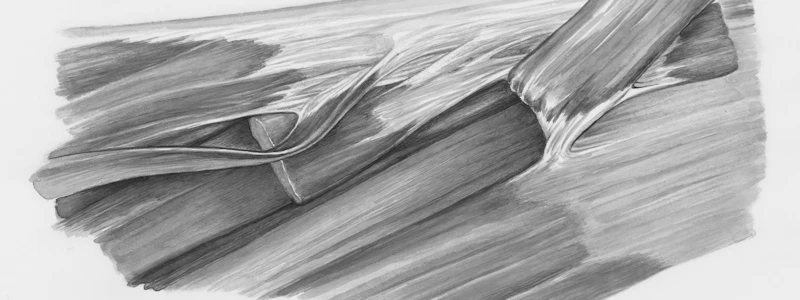Podcast
Questions and Answers
What does retroperitoneal mean?
What does retroperitoneal mean?
Located behind the peritoneum.
What does intraperitoneal mean?
What does intraperitoneal mean?
Within the peritoneal cavity.
What does primarily retroperitoneal refer to?
What does primarily retroperitoneal refer to?
Anterior surface only covered with peritoneum always.
What does secondarily retroperitoneal mean?
What does secondarily retroperitoneal mean?
Which of the following is a primary retroperitoneal organ? (Select all that apply)
Which of the following is a primary retroperitoneal organ? (Select all that apply)
Which of the following is considered a secondarily retroperitoneal organ? (Select all that apply)
Which of the following is considered a secondarily retroperitoneal organ? (Select all that apply)
What is mesentery?
What is mesentery?
What is the function of mesocolon?
What is the function of mesocolon?
What does the falciform ligament do?
What does the falciform ligament do?
What is the ligamentum teres?
What is the ligamentum teres?
Where are the coronary ligaments located?
Where are the coronary ligaments located?
What are triangular ligaments?
What are triangular ligaments?
What does the hepatoduodenal ligament connect?
What does the hepatoduodenal ligament connect?
What does the hepatogastric ligament connect?
What does the hepatogastric ligament connect?
What forms the lesser omentum?
What forms the lesser omentum?
What is the greater omentum?
What is the greater omentum?
What is the bare area of the liver?
What is the bare area of the liver?
What is the epiploic foramen?
What is the epiploic foramen?
What is the omental bursa?
What is the omental bursa?
What is the Pyramidalis muscle?
What is the Pyramidalis muscle?
Flashcards are hidden until you start studying
Study Notes
Retroperitoneal and Intraperitoneal
- Retroperitoneal: Refers to structures located behind the peritoneum, such as the kidney.
- Intraperitoneal: Refers to structures situated within the peritoneal cavity, including the liver and stomach.
Types of Retroperitoneal Structures
- Primarily Retroperitoneal: Organs that are always covered by the peritoneum on the anterior surface.
- Secondarily Retroperitoneal: Organs that began as intraperitoneal but became retroperitoneal during development.
Organs by Retroperitoneal Classification
- Primary Retroperitoneal Organs: Include the kidney, adrenal gland, ureter, aorta, inferior vena cava (IVC), lower esophagus, and upper rectum.
- Secondarily Retroperitoneal Organs: Include the duodenum, pancreas, and ascending and descending colon.
Mesentery and Ligaments
- Mesentery: A fused double layer of parietal peritoneum that attaches parts of the intestine to the abdominal wall; it connects organs to the body wall or to one another.
- Mesocolon: An extension of the mesentery that anchors the colon to the posterior abdominal wall.
Ligaments Associated with the Liver
- Falciform Ligament: Attaches the liver to the anterior abdominal wall and diaphragm; it is situated between the right and left lobes of the liver.
- Ligamentum Teres: A remnant of the umbilical vein.
- Coronary Ligaments: Connects the liver to the diaphragm.
- Triangular Ligaments: Formed at the apex of the coronary ligaments.
Omenta and Bursa
- Hepatoduodenal Ligament: Connects the liver to the duodenum.
- Hepatogastric Ligament: Connects the liver to the stomach.
- Lesser Omentum: Formed by the hepatogastric and hepatoduodenal ligaments.
- Greater Omentum: A double layer of peritoneum that attaches to the stomach and colon, covering the intestines; also known as the "apron of fat."
- Omental Bursa: A large portion of the greater omentum that drapes over the intestines.
Other Important Structures
- Bare Area of Liver: The part of the liver not covered by peritoneum.
- Epiploic Foramen: An opening leading to the lesser sac of the peritoneum.
- Pyramidalis Muscle: A small muscle located on the inferior surface of the rectus abdominis; if present, originates from the pubic crest and inserts into the linea alba.
Studying That Suits You
Use AI to generate personalized quizzes and flashcards to suit your learning preferences.



